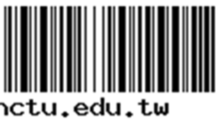Abstract
Quick Response Codes (QR Codes) have proved to be a great success in both automotive industry and general commercial use. However, in most cases, QR Codes are not identified as aesthetical, since the original motivation to invent QR Codes is to achieve high speed and high readability in scanning. This paper proposes a solution framework for QR Code abstraction, which produces machine readable QR Code that is visually similar to the input image. Unlike the existing schemes for QR Code abstraction, which produces QR Codes of low resolution, the framework aims to resolve the high computation complexity of producing halftone QR Codes of high resolution with both similarity and readability preserved. The solution framework has been implemented and tested on various input texts and images, and a user study was conducted to evaluate its performance in preserving similarity. The experimental results show that the framework can produce QR Codes of high resolution and high similarity without compromising readability.












Similar content being viewed by others
Explore related subjects
Discover the latest articles, news and stories from top researchers in related subjects.References
Analoui, M., Allebach, J.P.: Model-based halftoning using direct binary search. Proc. SPIE 1666, 96–108 (1992)
Bayer, B.: An optimum method for two-level rendition of continuous-tone pictures. In: IEEE International Conference on Communications, pp. 11–15. IEEE (1973)
Chang, J., Alain, B., Ostromoukhov, V.: Structure-aware error diffusion. ACM Trans. Graph. 28(5), 162:1–162:8 (2009)
Chu, H.K., Chang, C.S., Lee, R.R., Mitra, N.J.: Halftone qr codes. ACM Trans. Graph. 32(6), 217:1–217:8 (2013)
Cox, R.: Qart codes. http://research.swtch.com/qart. Accessed 08 Feb 2015
Eschbach, R., Knox, K.T.: Error-diffusion algorithm with edge enhancement. J. Optic. Soc. Am. A Optic. Image Sci. Vis. 8(12), 1844–1850 (1991)
Floyd, R., Steinberg, L.: An adaptive algorithm for spatial grey scale. In: SID International Symposium Digest of Technical Papers, pp. 36–37. Society for Information Display (1974)
Garateguy, G., Arce, G., Lau, D., Villarreal, O.: Qr images: optimized image embedding in qr codes. IEEE Trans. Image Process. 23(7), 2842–2853 (2014)
Geist, R., Reynolds, R., Suggs, D.: A Markovian framework for digital halftoning. ACM Trans. Graph. 12(2), 136–159 (1993)
Hara, M., Watabe, M., Nojiri, T., Nagaya, T., Uchiyama, Y.: Optically readable two-dimensional code and method and apparatus using the same. http://www.google.com/patents/US5726435 (1998). US Patent 5,726,435
Hwang, B.W., Kang, T.H., Lee, T.S.: Improved edge enhanced error diffusion based on first-order gradient shaping filter. In: Orchard, B., Yang, C., Ali, M. (eds.) Innovations in Applied Artificial Intelligence. Lecture Notes in Computer Science, vol. 3029, pp. 473–482. Springer, Heidelberg (2004)
Knuth, D.E.: Digital halftones by dot diffusion. ACM Trans. Graph. 6(4), 245–273 (1987)
Kwak, N.J., Ryu, S.P., Ahn, J.H.: Edge-enhanced error diffusion halftoning using human visual properties. In: International Conference on Hybrid Information Technology, vol. 1, pp. 499–504 (2006)
Lee, C., Allebach, J.: The hybrid screen—improving the breed. IEEE Trans. Image Process. 19(2), 435–450 (2010)
Lee, H.S., Kong, K.K., Hong, K.S.: Laplacian based structure-aware error diffusion. In: IEEE International Conference on Image Processing, pp. 525–528 (2010)
Li, H., Mould, D.: Contrast-aware halftoning. Eurographics 29(2), 273–280 (2010)
Neuhoff, D., Pappas, T., Seshadri, N.: One-dimensional least-squares model-based halftoning. In: IEEE International Conference on Acoustics, Speech, and Signal Processing, vol. 3, pp. 189–192 (1992)
Ono, S., Morinaga, K., Nakayama, S.: Two-dimensional barcode decoration based on real-coded genetic algorithm. In: IEEE Congress on Evolutionary Computation, pp. 1068–1073 (2008)
Ostromoukhov, V.: A simple and efficient error-diffusion algorithm. In: Proceedings of the 28th Annual Conference on Computer Graphics and Interactive Techniques, SIGGRAPH ’01, pp. 567–572. ACM (2001)
Pang, W.M., Qu, Y., Wong, T.T., Cohen-Or, D., Heng, P.A.: Structure-aware halftoning. ACM Trans. Graph. (SIGGRAPH 2008 issue) 27(3), 89:1–89:8 (2008)
Pappas, T., Allebach, J., Neuhoff, D.: Model-based digital halftoning. IEEE Signal Process. Mag. 20(4), 14–27 (2003)
Pelet, U.: Visualead. http://www.visualead.com/ (2012)
Samretwit, D., Wakahara, T.: Measurement of reading characteristics of multiplexed image in qr code. In: International Conference on Intelligent Networking and Collaborative Systems, pp. 552–557. IEEE (2011)
A T COMMUNICATIONS: Logoqnet. http://logoq.net/logoq/index.html (2007)
Ulichney, R.: Dithering with blue noise. Proc. IEEE 76(1), 56–79 (1988)
Wang, S., Cai, K., Lu, J., Liu, X., Wu, E.: Real-time coherent stylization for augmented reality. Vis. Comput. 26(6–8), 445–455 (2010)
Wang, Z., Bovik, A., Sheikh, H., Simoncelli, E.: Image quality assessment: from error visibility to structural similarity. IEEE Trans. Image Process. 13(4), 600–612 (2004)
Zang, Y., Huang, H., Li, C.F.: Artistic preprocessing for painterly rendering and image stylization. Vis. Comput. 30(9), 969–979 (2014)
Zhou, B., Fang, X.: Improving mid-tone quality of variable-coefficient error diffusion using threshold modulation. ACM Trans. Graph. 22(3), 437–444 (2003)
Acknowledgments
The authors would like to thank all reviewers for their helpful suggestions and constructive comments. The work is supported by the National Natural Science Foundation of China (No. 61202154, 61272326, 61133009), the National Basic Research Project of China (No. 2011CB302203), National Key Technology R&D Program (No. 2012BAH55F02), Shanghai Pujiang Program (No. 13PJ1404500), the Grant of University of Macau under Grant No. MYRG2014-00139-FST and MYRG202(Y1-L4)-FST11-WEH, the Science and Technology Commission of Shanghai Municipality Program (No. 13511505000), the Interdisciplinary Program of Shanghai Jiao Tong University (No. 14JCY10), and the Open Project Program of the State Key Lab of CAD&CG (No. A1401), Zhejiang University.
Author information
Authors and Affiliations
Corresponding author
Rights and permissions
About this article
Cite this article
Qiao, S., Fang, X., Sheng, B. et al. Structure-aware QR Code abstraction. Vis Comput 31, 1123–1133 (2015). https://doi.org/10.1007/s00371-015-1107-x
Published:
Issue Date:
DOI: https://doi.org/10.1007/s00371-015-1107-x




